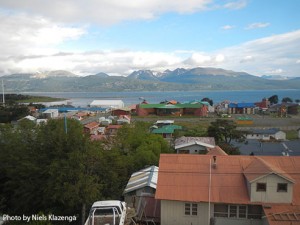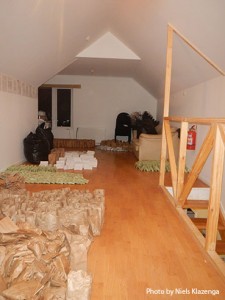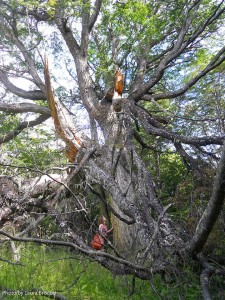From the Field: Bill Buck in Cape Horn 2013, Day 11
Posted in Bill Buck, From the Field, Science on March 5 2013, by William R. Buck
January 20, 2013, Prov. Antártica Chilena, Comuna Cabo de Hornos, Isla Navarino, Puerto Williams, 54°56’S, 67°37’W
 I wake up at 5 a.m. and get out of bed. I know sunrise is around this time and that we will be arriving in Puerto Williams shortly thereafter. My early morning is well rewarded; the sunrise is gorgeous, increasing in intensity of pale yellows, pinks, and oranges all on a pale blue palette. The temperature is warm–I am comfortable standing on the upper deck in just my sleeping clothes. The captain and I wave at each other and both go back to our own thoughts. In the distance, on the left (south) shore is a small group of lights that I think must be Puerto Williams and when I point at them the captain confirms my assumption.
I wake up at 5 a.m. and get out of bed. I know sunrise is around this time and that we will be arriving in Puerto Williams shortly thereafter. My early morning is well rewarded; the sunrise is gorgeous, increasing in intensity of pale yellows, pinks, and oranges all on a pale blue palette. The temperature is warm–I am comfortable standing on the upper deck in just my sleeping clothes. The captain and I wave at each other and both go back to our own thoughts. In the distance, on the left (south) shore is a small group of lights that I think must be Puerto Williams and when I point at them the captain confirms my assumption.
Several hours earlier I was up at 1:30 a.m., and to the north the whole coast was ablaze with lights over a large area: Ushuaia. Tiny Puerto Williams provides quite the contrast to Ushuaia. Puerto Williams’ population is around 2,200, which, in actuality, is the population of the entire province with the vast majority of those people living in this, the province’s only town. Puerto Williams is not only the provincial capital of Antártica Chilena, it is also the largest southernmost permanent settlement in the world (there is actually a very small town somewhat further south that is attainable only by ship and that we’ll visit later). It is also a navy town and run by the military for all practical purposes. I first came to Puerto Williams in 2000 and the town has scarcely changed in the intervening years. Indeed, it probably hasn’t changed much in a considerably longer time.
About 6 a.m. I ask the captain if we will need our passports, because I suspect the navy keeps track of people coming and going on the island, but the captain says he doesn’t think so. However, after several radio messages back and forth he tells me that we will indeed need to present our passports upon arrival. So, half an hour later when I am still the only one up, I return to the bunk room, turn on the lights, and ask everyone for their passports. Around 7 a.m. the captain carries them ashore while we wait on the ship. I don’t know if it is because it is Sunday or just an example of military bureaucracy, but we are not allowed ashore until 11:30 a.m. During this time the ship is asked to move out into the harbor, away from the dock.
Most people get up shortly after my wake up call and we eat breakfast early. We pass the time waiting for the return of our passports by packing up all our gear because for the next three nights we will sleep ashore at the Universidad de Magallanes field station in Puerto Williams. Laura and I were here last year for the inauguration ceremony.
 During this prime field season there are usually several groups of students and independent researchers staying at the facility. The building has six bedrooms, each sleeping four, and two bathrooms. In addition to the accommodations and communal kitchen, there is also a large laboratory/workroom/classroom, and a large, empty third floor where we can spread out our collections to dry. In order to free up space on the ship for the second half of our trip we have brought ashore all the collections we have already made. We are mostly glad of the temporary use of larger, more spacious bunks and dependable hot showers, even if only for three nights. Nevertheless, there is something jarring about being back in civilization. Even in a town as small as Puerto Williams, there is no comparison to the tranquility of life on board the ship when we are anchored in an isolated harbor.
During this prime field season there are usually several groups of students and independent researchers staying at the facility. The building has six bedrooms, each sleeping four, and two bathrooms. In addition to the accommodations and communal kitchen, there is also a large laboratory/workroom/classroom, and a large, empty third floor where we can spread out our collections to dry. In order to free up space on the ship for the second half of our trip we have brought ashore all the collections we have already made. We are mostly glad of the temporary use of larger, more spacious bunks and dependable hot showers, even if only for three nights. Nevertheless, there is something jarring about being back in civilization. Even in a town as small as Puerto Williams, there is no comparison to the tranquility of life on board the ship when we are anchored in an isolated harbor.
After settling in, we return to the ship for lunch. In general we have decided to bring food from the ship to the field station for breakfasts, to return to the ship for lunches, and to go out for dinner at local restaurants that Ernesto has arranged for us each night.

It is already 4 p.m. by the time we are ready to go into the field. I think mainly we just want to get outside and move around after so many hours of inactivity. We drive 3 kilometers west of town to Parque Etnobotánico Omora. It was the formation of this park that was the reason for my first visit to Chile. When the Chilean government established this park they asked the local indigenous peoples about the plant biodiversity of the area. In this landscape, bryophytes and lichens are significantly more diverse than vascular plants (JSTOR link, subscription may be required), and as part of the founding of this park, I was invited to participate in inventorying the bryophyte populations. The rest is history, and without querying my old field books, I cannot tell you with any certainty how many times I have been here now.
Walking the trails of this familiar park is like a homecoming. I don’t make a single collection–nor do some of the others. I simply enjoy walking around and reacquainting myself with the vegetation. Disappointingly we are unable to find the dung moss, Tayloria mirabilis, which, believe it or not, is the “poster child” for the park. The weather is uncharacteristically mild, even uncomfortably warm at times.
Dinner at a restaurant where we can order off a menu seems like such a luxury. I think we all appreciate the change in diet, albeit brief. At dinner we discuss the upcoming Navarino fieldwork. We have two days planned, one of which will be up Pico de la Bandera (a 2,000 foot peak that is part of the Dientes de Navarino) and the other along the north shore road. I decide that if tomorrow brings more sun and warmth, we will go up the mountain, and if it is cold and raining we will do the road trip.
Ed. note: NYBG scientist and Mary Flagler Cary Curator of Botany, Bill Buck has just returned from his annual expedition to the islands off Cape Horn, the southernmost point in South America, to study mosses and lichens. For the past two years he was able to file stories from the field, but this year’s locations proved so remote he was forced to wait until his return. We will be publishing them over the course of several days. Follow his journeys on Plant Talk.
Bill Buck’s Previous Reports From the Field:
2013
January 10, 2013, Punta Arenas, Chile
2012
February 5, 2012; Isla Londonderry, Puerto Fortuna, approximately 54º54’S, 70º26’W
February 4, 2012; Isla O’Brien, Caleta Americana, approximately 54º53’S, 70º23’W
February 3, 2012; Isla Grande de Tierra del Fuego, Fiordo Garibaldi, approximately 54º58’S, 69º49’W
February 2, 2012; Isla Gordon, middle arm of Bahía Tres Brazos, approximately 54º58’S, 69º41’W
January 31, 2012; Isla Gordon, Bahía Romanche, 54º57’S, 69º30’W
January 30, 2012; Isla Gordon, Bahía Romanche, 54º57’S, 69º30’W
January 25, 2012; Isla Darwin, Caleta Virginia, approximately 54º57’S, 70º10’W
January 23, 2012; Arm of Estero Webb, SW coast of Isla Hoste, approximately 55º14’S, 69º41’W
January 22, 2012.; Unnamed sound on Isla Gordon behind Cabo El Gorro, approximately 55º02’S, 69º48’W
January 21, 2012; Isla Hoste, Estero Fouque, 55º1’S, 69º35’W
January 20, 2012; Isla Hoste, Estero Fouque, approximately 55º11’S, 69º35’W
January 18, 2012; Canal O’Brien, just south of Isla O’Brien, 54º55’S, 70º35’W
January 17, 2012; Punta Arenas, Chile
2011
July 15, 2011; Hobart, Tasmania, Australia
July 14, 2011; Pyengana, Tasmania, Australia
July 13, 2011; Weldborough, Tasmania, Australia
July 12, 2011; Hobart, Tasmania, Australia
July 11, 2011; Hobart, Tasmania, Australia
February 8, 2011; Punta Arenas, Chile
February 5, 2011, unnamed sound northwest of Isla Georgiana
February 4, 2011, unnamed sound directly east of Seno Mama, Chile
February 2, 2011, Seno Courtenay, northern arm, Chile
February 1, 2011, Seno Courtenay, Chile
January 31, 2011, Canal between Isla Georgiana and Isla Clementina,, Chile
January 30, 2011, Unnamed sound on south side of Brecknock Peninsula, NW of Isla Georgiana, Chile
January 29, 2011, Isla Aguirre, Seno Quo Vadis, Chile
January 26, 2011, Punta Arenas, Chile
January 24, 2011, Seno Chasco, just north of isthmus to Brecknock Peninsula, Chile
January 23, 2011, Isla Grande de la Tierra del Fuego, Puerto Consuelo, Seno Chasco, Chile
January 22, 2011, Isla Grande de la Tierra del Fuego, Seno Brujo, Chile
January 21, 2011, Isla Grande de la Tierra del Fuego, Seno Brujo, Chile
January 20, 2011, Isla Grande de la Tierra del Fuego, Seno Bluff, Chile

